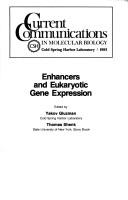| Listing 1 - 4 of 4 |
Sort by
|

ISBN: 0879691611 9780879691615 Year: 1983 Publisher: Cold Spring Harbor Cold Spring Harbor laboratory
Abstract | Keywords | Export | Availability | Bookmark
 Loading...
Loading...Choose an application
- Reference Manager
- EndNote
- RefWorks (Direct export to RefWorks)
Cells, Cultured --- Genes, Regulator --- Enhancer Elements, Genetic --- Gene Expression Regulation --- Eukaryotic Cells --- Gene expression --- Genetic transcription --- Eukaryotic cells --- Congresses --- Cells. --- Cell Biology. --- Gene Expression Regulation. --- Genes. --- Genes, Regulator. --- -Eukaryotic cells --- -Eucaryotic cells --- Cells --- Protista --- Transcription (Genetics) --- Genetic code --- Gene, Regulator --- Regulator Gene --- Regulator Genes --- Regulatory Genes --- Gene, Regulatory --- Genes, Regulatory --- Regulatory Gene --- Genes, Modifier --- Cistron --- Gene --- Genetic Materials --- Cistrons --- Genetic Material --- Material, Genetic --- Materials, Genetic --- Genome --- Expression Regulation, Gene --- Regulation, Gene Action --- Regulation, Gene Expression --- Gene Action Regulation --- Regulation of Gene Expression --- RNAi Therapeutics --- Gene Regulatory Networks --- Cellular Biology --- Cytology --- Biologies, Cell --- Biologies, Cellular --- Biology, Cell --- Biology, Cellular --- Cell Biologies --- Cellular Biologies --- Cell --- Cell Biology --- Congresses. --- -Congresses --- Genes --- Cells, Cultured - congresses --- Genes, Regulator - congresses --- Enhancer Elements, Genetic - congresses --- Gene Expression Regulation - congresses --- Gene expression - Congresses --- Genetic transcription - Congresses --- Eukaryotic cells - Congresses
Book
ISBN: 1281513121 9786611513122 3540773495 3540773487 3642445136 Year: 2008 Publisher: Berlin, Heidelberg : Springer Berlin Heidelberg : Imprint: Springer,
Abstract | Keywords | Export | Availability | Bookmark
 Loading...
Loading...Choose an application
- Reference Manager
- EndNote
- RefWorks (Direct export to RefWorks)
The earliest observation of cytomegalovirus (CMV) interactions with the host cell was owl eye cytopathology in various tissues. It was recognized in the early 1970s that human CMV caused in utero infections resulting in congenital brain damage and other sensory neurological complications. Events of the 1980s and early 1990s, such as the wide application of solid organ and bone marrow transplantation and the emergence of AIDS, put the spotlight on human CMV. We understood that the virus was an opportunistic agent associated with immunosuppression. The golden age of cytomegalovirus research was ushered in during the late 1970s and early 1980s by a set of powerful new technologies that included restriction enzymes, DNA cloning, DNA sequencing, and open reading frame prediction. The genetic manipulation and propagation of novel CMV strains was accelerated with the app- cation of bacterial artificial chromosome technology. Today, we still struggle to understand the full spectrum of disease associated with human CMV. To the molecular biologist, CMV is a master of regulation in the eukaryotic cell where it either replicates or remains latent. To the immunologist, CMV is a master of immune evasion with tools to escape both the innate and acquired immune responses. The use of animal models with non-human CMVs has become significantly more sophisticated and tied to a more certain understanding of the interrelationships of non-human and human CMV genes.
Cytomegalovirus infections. --- Cytomegaloviruses. --- Salivary gland viruses --- Herpesviruses --- CMV infections --- Cytomegalovirus disease --- Herpesvirus diseases --- Medical virology. --- Virology. --- Medical microbiology --- Virology --- Virus diseases --- Microbiology
Digital
ISBN: 9783540773498 Year: 2008 Publisher: Berlin, Heidelberg Springer-Verlag Berlin Heidelberg
Abstract | Keywords | Export | Availability | Bookmark
 Loading...
Loading...Choose an application
- Reference Manager
- EndNote
- RefWorks (Direct export to RefWorks)
Book
ISBN: 9783540773498 Year: 2008 Publisher: Berlin Heidelberg Springer Berlin Heidelberg
Abstract | Keywords | Export | Availability | Bookmark
 Loading...
Loading...Choose an application
- Reference Manager
- EndNote
- RefWorks (Direct export to RefWorks)
The earliest observation of cytomegalovirus (CMV) interactions with the host cell was owl eye cytopathology in various tissues. It was recognized in the early 1970s that human CMV caused in utero infections resulting in congenital brain damage and other sensory neurological complications. Events of the 1980s and early 1990s, such as the wide application of solid organ and bone marrow transplantation and the emergence of AIDS, put the spotlight on human CMV. We understood that the virus was an opportunistic agent associated with immunosuppression. The golden age of cytomegalovirus research was ushered in during the late 1970s and early 1980s by a set of powerful new technologies that included restriction enzymes, DNA cloning, DNA sequencing, and open reading frame prediction. The genetic manipulation and propagation of novel CMV strains was accelerated with the app- cation of bacterial artificial chromosome technology. Today, we still struggle to understand the full spectrum of disease associated with human CMV. To the molecular biologist, CMV is a master of regulation in the eukaryotic cell where it either replicates or remains latent. To the immunologist, CMV is a master of immune evasion with tools to escape both the innate and acquired immune responses. The use of animal models with non-human CMVs has become significantly more sophisticated and tied to a more certain understanding of the interrelationships of non-human and human CMV genes.
| Listing 1 - 4 of 4 |
Sort by
|

 Search
Search Feedback
Feedback About UniCat
About UniCat  Help
Help News
News